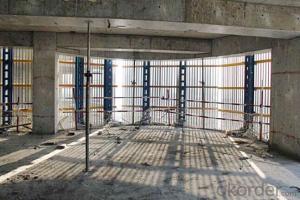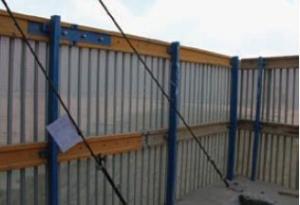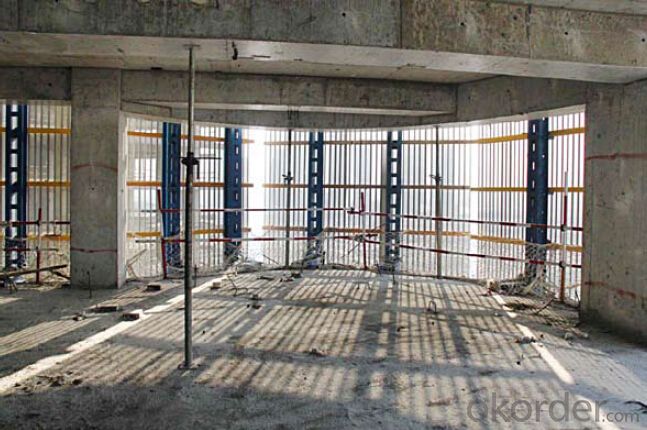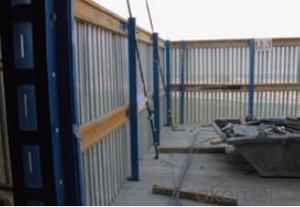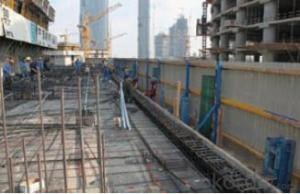Protection-Platform for Formwork and scaffolding systems
- Loading Port:
- Tianjin
- Payment Terms:
- TT OR LC
- Min Order Qty:
- 50 m²
- Supply Capability:
- 1000 m²/month
OKorder Service Pledge
OKorder Financial Service
You Might Also Like
Protection Platform PP-50
A kind of new type construction protection system, applying operating platform and safer job
location for construction corps.
Characteristics:
◆ Easy and quick assembling.
◆ Lifted as a group, it is rapid and economic.
◆ Auto-climbing
◆ A safe and reliable anchor system
1. Composition
2. Assembly process of anchor system
(1) Embed V-climbing cone and anchor plate into the slab.
(2) Fix anchor shoe on the slab by tensile bolt.
(3) The fixed anchor shoe.
◆ High work efficiency with work platform and unload platform
◆ High light transmittance with the hollow block
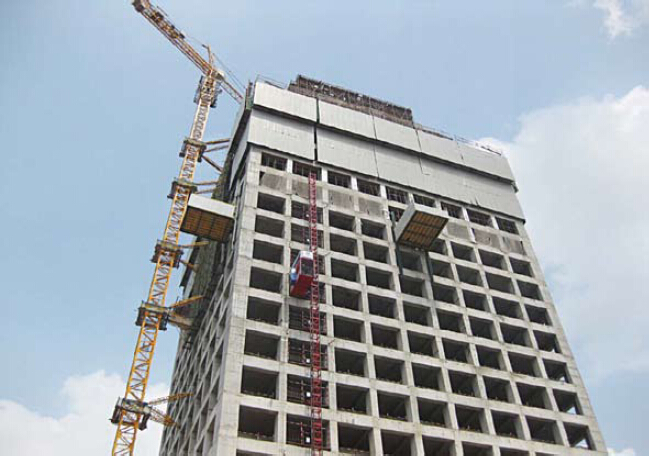

- Q: How does steel formwork handle formwork stripping and repositioning?
- Steel formwork is an option that is highly durable and versatile for the handling of formwork stripping and repositioning. It is designed to withstand the pressure exerted during the concrete pouring process and can easily manage the removal of the formwork once the concrete has set. When it comes to the removal of formwork, steel formwork offers several advantages. Firstly, it ensures a high-quality end result by providing a smooth surface finish to the concrete. The steel panels are typically coated with a protective layer, preventing concrete from sticking to the formwork and making stripping easier. The steel formwork system is engineered to facilitate quick and efficient formwork removal. This is achieved through the use of various mechanisms such as wedge clamps, pins, or hooks, which securely hold the formwork panels in place during the pouring process. Once the concrete has gained sufficient strength, these mechanisms can be easily released, allowing for smooth and effortless stripping of the formwork. Furthermore, steel formwork can be easily repositioned and reused for multiple construction projects. The modular design of steel panels allows for flexibility in adjusting the formwork to different dimensions and shapes. This reusability significantly reduces the overall cost of formwork, making it a cost-effective solution for construction projects. In addition, steel formwork provides excellent strength and stability, ensuring the integrity of the structure throughout the formwork stripping and repositioning process. This is particularly crucial in high-rise or complex structures where the formwork must withstand significant loads and pressures. In conclusion, steel formwork is a dependable and efficient choice for handling formwork stripping and repositioning. Its durability, ease of use, and adaptability make it the preferred option for construction projects of various sizes and complexities.
- Q: Are there any specific considerations for using steel formwork in earthquake-prone areas?
- Yes, there are specific considerations for using steel formwork in earthquake-prone areas. Steel formwork is known for its strength and durability, which is why it is often preferred in seismic regions. However, there are several factors that need to be taken into account when using steel formwork in earthquake-prone areas: 1. Flexibility: Steel formwork should be designed to have the necessary flexibility to withstand seismic forces. It should be able to absorb and dissipate the energy generated during an earthquake, reducing the risk of structural damage. 2. Connection details: The connection details between the steel formwork components should be carefully designed and engineered to ensure proper load transfer and resistance to seismic forces. Special attention should be given to the joints and connections to prevent failure or collapse during an earthquake. 3. Reinforcement: Additional reinforcement might be required to enhance the strength and stiffness of the steel formwork system. This reinforcement can be in the form of additional steel bars, cross bracing, or diagonal struts to provide increased resistance against lateral forces. 4. Anchorage: Proper anchorage of the steel formwork to the supporting structure is crucial in earthquake-prone areas. The formwork should be securely anchored to the foundation or the structural elements to prevent displacement or movement during an earthquake. 5. Inspection and maintenance: Regular inspection and maintenance of the steel formwork system are essential in earthquake-prone areas. Any damage or wear should be identified and repaired promptly to ensure the integrity and stability of the formwork system. 6. Compliance with building codes: It is important to ensure that the steel formwork system complies with the local building codes and regulations for seismic design. These codes provide guidelines and requirements for the design, installation, and use of formwork in earthquake-prone areas. By considering these specific factors, using steel formwork in earthquake-prone areas can provide enhanced structural resilience and contribute to the overall safety and durability of the construction project.
- Q: How is steel formwork transported to the construction site?
- Steel formwork is typically transported to the construction site using various methods depending on the distance, quantity, and accessibility of the site. One common method is by truck, where the steel formwork components are loaded onto a flatbed or trailer and driven to the construction site. This method is suitable for shorter distances and smaller quantities of formwork. For larger quantities or longer distances, steel formwork may be transported by rail or by sea. Rail transport allows for the efficient movement of large quantities of formwork over long distances, especially when the site is located far from the manufacturing facility. Sea transport, on the other hand, is ideal for international projects where the formwork needs to be shipped overseas. The formwork is usually loaded into shipping containers and transported by cargo ships. Once the steel formwork arrives at the construction site, it is typically unloaded using cranes or forklifts. The formwork components are then stored in a designated area until they are ready to be installed. It is important to ensure that the transportation process is carefully planned and executed to avoid any damage to the formwork, as any structural integrity issues can affect the quality and safety of the final construction.
- Q: How does steel formwork handle concrete surface blemishes?
- Steel formwork is known for its durability and strength, which helps in handling concrete surface blemishes effectively. Due to its rigid structure, steel formwork provides a smooth and even surface for pouring and shaping concrete. This minimizes the occurrence of blemishes such as air pockets, cracks, or unevenness. Additionally, steel formwork offers better control over the pouring and curing process, reducing the chances of surface imperfections. Overall, steel formwork ensures a high-quality finish and helps to minimize concrete surface blemishes.
- Q: Can steel formwork be easily dismantled and removed after construction?
- Steel formwork is designed to be easily dismantled and removed after construction, providing a cost-effective and sustainable option for construction projects. It can withstand the weight and pressure of the concrete during the construction process. Once the construction is complete and the concrete has cured, the steel formwork can be dismantled using basic tools like hammers and wrenches. The individual components of the formwork can be unbolted and removed from the concrete structure. After dismantling, the steel formwork can be cleaned, inspected, and stored for future use, reducing the need for new formwork in future construction projects. In conclusion, the use of steel formwork offers the advantage of easy dismantling and removal, contributing to its cost-effectiveness and sustainability in construction projects.
- Q: How does steel formwork contribute to the overall fire safety of the building?
- The inherent properties and characteristics of steel formwork make it a valuable asset in enhancing the fire safety of a building. Firstly, steel formwork is renowned for its exceptional fire resistance. Its high melting point and resistance to ignition and burning make it a suitable choice for construction in fire-prone areas. In case of a fire, steel formwork remains structurally stable, serving as a vital barrier that contains the fire and prevents its spread to other sections of the building. This is particularly crucial in tall buildings where fire safety is of utmost importance. Furthermore, steel formwork is non-combustible, thereby minimizing the release of flammable gases and toxic fumes when exposed to fire. This is essential for the safety of occupants as smoke inhalation and toxic gases are leading causes of casualties in fire incidents. The utilization of steel formwork reduces the risk of smoke and toxic gases permeating throughout the building, allowing occupants more time to evacuate safely. Moreover, steel formwork is a durable and robust material capable of withstanding the impact of fire while retaining its structural integrity. This is vital in ensuring the stability of the building during a fire, preventing collapse, and reducing the likelihood of injuries or fatalities. Steel formwork can also resist the effects of high temperatures, such as thermal expansion, further contributing to the fire safety of the building. In conclusion, steel formwork plays a crucial role in enhancing the overall fire safety of a building. Its high fire resistance, non-combustible nature, and durability help contain fires, minimize the spread of smoke and toxic gases, and maintain the structural integrity of the building. By incorporating steel formwork into construction, the risk of fire-related incidents and their potential consequences can be significantly reduced, ensuring the safety of occupants and property.
- Q: How does steel formwork handle different concrete surface cleaning methods?
- Concrete construction projects can benefit from the durability and versatility of steel formwork. When it comes to cleaning the concrete surface, steel formwork proves to be highly effective and adaptable. Pressure washing is a common method used to clean concrete surfaces. Steel formwork can withstand the force of high-pressure water jets without sustaining any damage. The smooth and non-porous nature of the steel formwork surface facilitates the removal of dirt, debris, and other unwanted materials. By utilizing pressure washing, a smooth and even finish can be achieved. Chemical cleaning is another technique employed for cleaning concrete surfaces. Steel formwork is resistant to the majority of chemicals commonly used for cleaning purposes. This allows for the usage of various cleaning agents to eliminate stubborn stains, oil, grease, and other contaminants from the concrete surface. The chemical cleaning process can be carried out without causing any harm or deterioration to the steel formwork. Manual cleaning methods may also be utilized in certain instances. Steel formwork can withstand manual scrubbing, brushing, or scraping without any issues. The strength and durability of steel make it suitable for manual cleaning methods, which may be necessary when dealing with tough stains or debris that cannot be easily removed through other means. In conclusion, steel formwork is an ideal choice for handling various concrete surface cleaning methods. Its resistance to pressure washing, chemical cleaning, and manual cleaning ensures that the concrete surface can be effectively cleaned without damaging the formwork. This allows for a clean and visually appealing finish while maintaining the structural integrity of the formwork.
- Q: Can steel formwork be easily modified or adjusted during concrete placement?
- Yes, steel formwork can be easily modified or adjusted during concrete placement. Steel formwork is known for its versatility and flexibility, allowing for easy modifications or adjustments as per the requirements of the concrete structure. Steel formwork systems are typically designed with adjustable components such as panels, beams, and props, which can be easily repositioned or moved to accommodate changes in the design or dimensions of the concrete structure. These adjustable components can be quickly and securely locked into place, providing stability and support during concrete placement. Additionally, steel formwork allows for the use of various formwork accessories such as clamps, connectors, and ties, which further enhance its adaptability and ease of modification. Overall, steel formwork provides a highly efficient and flexible solution for adjusting or modifying formwork during concrete placement.
- Q: Is steel formwork suitable for projects with heavy concrete loads?
- Yes, steel formwork is highly suitable for projects with heavy concrete loads. Steel formwork is known for its strength, durability, and load-bearing capacity, making it ideal for projects that involve heavy concrete loads. Steel formwork can withstand the pressure and weight of the concrete, ensuring that it maintains its shape and integrity throughout the pouring and curing process. Additionally, steel formwork offers excellent dimensional accuracy, allowing for precise and consistent concrete placement, which is crucial for projects with heavy loads. Overall, steel formwork is a reliable and robust choice for projects that require the support of heavy concrete loads.
- Q: What are the common safety precautions when working with steel formwork in extreme temperatures?
- When working with steel formwork in extreme temperatures, some common safety precautions include wearing appropriate personal protective equipment (PPE) such as heat-resistant gloves and clothing, ensuring proper hydration by drinking plenty of water, taking frequent breaks in shaded or air-conditioned areas, and avoiding direct exposure to the sun for extended periods. Additionally, it is important to be aware of the signs of heat-related illnesses such as heat exhaustion or heat stroke and to seek medical attention if necessary. Regular communication and monitoring of workers' well-being is also crucial to ensure their safety in such conditions.
Send your message to us
Protection-Platform for Formwork and scaffolding systems
- Loading Port:
- Tianjin
- Payment Terms:
- TT OR LC
- Min Order Qty:
- 50 m²
- Supply Capability:
- 1000 m²/month
OKorder Service Pledge
OKorder Financial Service
Similar products
Hot products
Hot Searches
Related keywords
